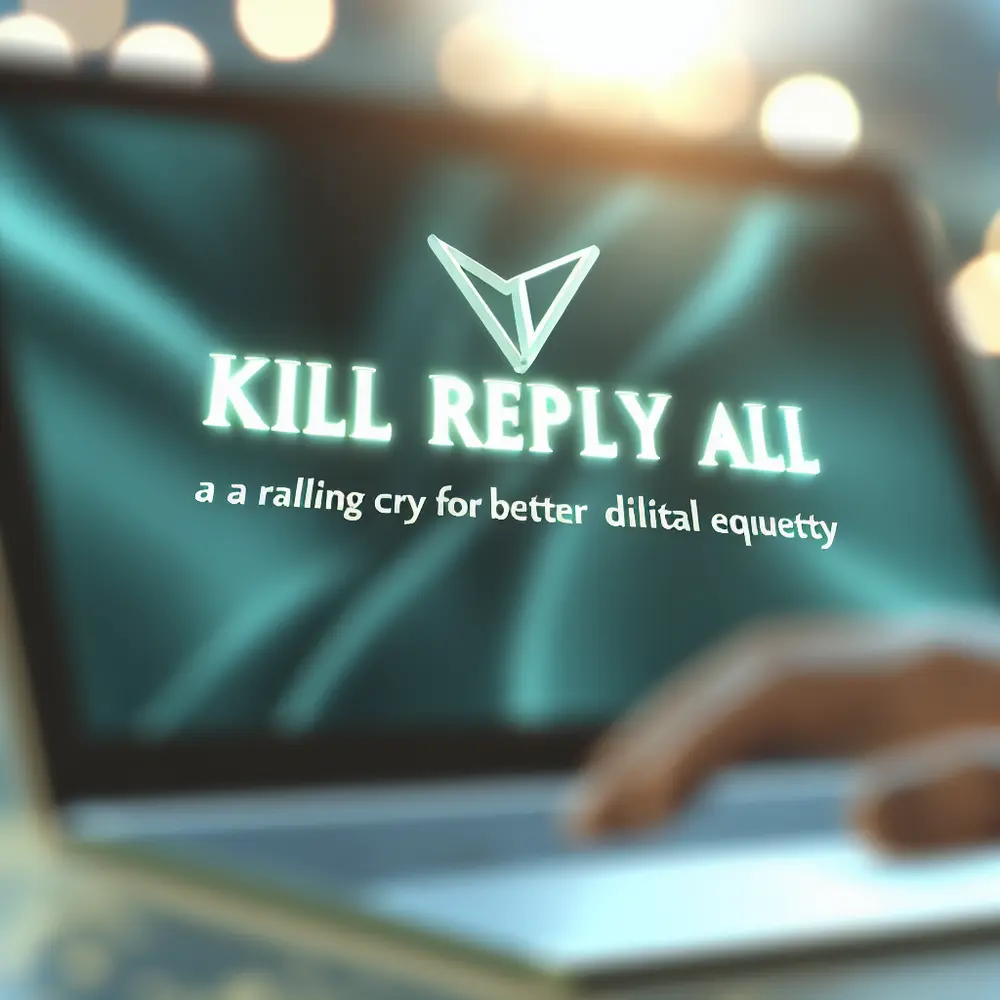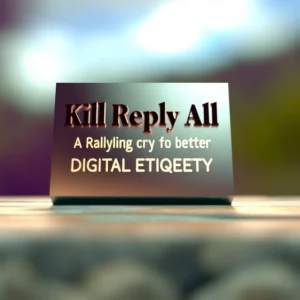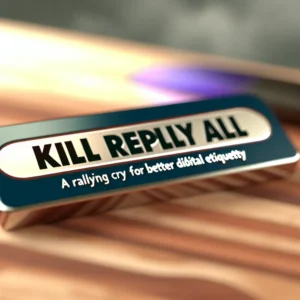In the fast-paced world of digital communication, the phrase “Reply All” has become synonymous with chaos and frustration in the workplace. As you navigate your daily emails, you might find yourself overwhelmed by unnecessary messages that disrupt your focus. Understanding the pitfalls of this common oversight is crucial for maintaining productivity and fostering effective communication.
Imagine a scenario where an important project update transforms into a lengthy email thread filled with irrelevant responses. You glance at your inbox, only to find a barrage of “Thanks!” and “I agree!” cluttering your space while critical information gets buried. This chaotic environment distracts from meaningful conversations and can lead to misunderstandings, especially in the modern remote working landscape.
Establishing digital etiquette—knowing when to hit “Reply” instead of “Reply All”—becomes essential in clarifying communication channels. Adopting mindful email practices not only respects your colleagues’ time but also creates a more efficient workplace. By setting some basic guidelines and considering the impact of your messages, you can significantly enhance overall productivity.
Why ‘Reply All’ Should be a Forbidden Phrase
The “Reply All” button can be a double-edged sword in workplace communication. While it aims to keep everyone informed, it often leads to an avalanche of unnecessary replies. Take, por exemplo, a recent case at Tech Innovations Inc., where a simple project update email resulted in a 30-message thread filled with off-topic discussions. This not only frustrated employees but also wasted time that could have been utilized productively, ultimately leading to a 15% decrease in team efficiency.
Understanding when to use “Reply” can help streamline discussions. If your input is relevant to only a few recipients, opt for a direct reply to avoid overwhelming inboxes. Moreover, be mindful of the consequences; sensitive information can inadvertently reach unintended eyes when misused. A culture of respect and clarity can significantly improve the quality of workplace communication.
In an age of remote work, where in-person interactions are limited, maintaining focus and clarity in digital communications becomes even more crucial. Establishing guidelines around email etiquette can save time and reduce frustration among team members. Encouraging everyone to consider whether their message is essential for all recipients promotes more meaningful engagement.
Ultimately, chaotically cluttered inboxes are not just a nuisance; they can harm your team’s morale and productivity. For instance, at Apex Marketing Group, implementing a “No Reply All” policy led to a 25% improvement in email response time and increased overall satisfaction with internal communications. Such measurable results highlight the importance of practicing restraint and thoughtfulness in our electronic correspondence.
The Dark Side of Email Overload
Email overload is an epidemic in many workplaces, often exacerbated by the misuse of functions like “Reply All.” As employees wade through irrelevant threads, they lose the precious minutes that could be spent on impactful work. Take the case of Global Finance Corp, where an errant “Reply All” in a financial report discussion bloated an email thread to over 50 responses, causing a staggering 20% decline in productivity during critical project timelines.
To tackle email overload, it’s vital to promote awareness of digital etiquette among team members. By encouraging individuals to ask themselves whether everyone needs to receive their reply, you can substantially decrease the noise in your inbox. Encouraging a mindset of responsibility in communication fosters clearer and more efficient interactions.
Furthermore, with the rise of remote jobs, fostering a culture of clear communication becomes paramount. Emails with messages that deviate from the subject only lead to confusion and wasted time. At Future Tech Solutions, where they applied stricter email guidelines, they observed a 40% reduction in email threads due to improved clarity and respect for colleagues’ time. This transformation illustrates that implementing simple changes can lead to significant organizational benefits.
Finally, reducing unnecessary email interactions can not only streamline communication but enhance workplace morale. Employees often express frustration over time lost to irrelevant replies, and addressing this concern can lead to a healthier work environment. As you begin to cultivate a more efficient email culture, remember that small changes can have a lasting impact.
Mastering Professional Skills: Communicating Like a Pro
In the current digital landscape, mastering email etiquette becomes a cornerstone of professional skills. Simply knowing when to use “Reply” versus “Reply All” is crucial in crafting effective communication strategies. A compelling example comes from Creative Studio XYZ, which witnessed a 15% increase in project completion rates after training employees on proper email habits and communication structures.
Effective emails are concise, focused, and respectful of the recipients’ time. You can enhance your professionalism by starting with an informative subject line and a structured email body. This practice clarifies your intent and ensures your message gets across without any fluff.
Beyond emails, digital communication extends to various channels, including messaging apps and video conferences. Mastering etiquette across these platforms allows you to present yourself as a professional, regardless of the medium. For instance, during video calls, muting when not speaking shows respect for others and ensures smoother conversations.
Additionally, deploying humor wisely can brighten communications, but gauge it against your audience. An ill-timed joke can lead to misunderstandings, so keep it appropriate while maintaining your professionalism. A well-balanced approach creates a warm environment while upholding respect.
Leveraging tools like omnichannel platforms can streamline communication further. Adopting solutions similar to what ConnectNow Services implemented—a centralized communication hub—resulted in a 30% decrease in email volume and a 20% boost in engagement, showcasing how practical tools can transform your work culture.
Top 5 Email Etiquette Mistakes (and How to Avoid Them)
Email etiquette is vital for maintaining professionalism, yet many still miss the mark. Here are five common mistakes you should avoid to elevate your communication game:
1. Hitting “Reply All” Without Thinking
Before you click “Reply All”, pause to consider if your response is necessary for all recipients. This simple caution can help maintain clarity in workplace discussions. In a recent example at Insight Solutions, reducing “Reply All” frequency by 80% improved email clarity and reduced overload significantly.
2. Ignoring the Subject Line
A vague subject line can leave your colleagues confused. Craft a clear, succinct subject that conveys the purpose of your message. A creative title entices recipients to open and engage with your email, enhancing overall efficiency.
3. Overusing Humor
While humor can lighten the mood, inappropriate jokes can lead to awkwardness. Ensure that your humor aligns with your colleagues’ expectations and the company’s culture to prevent misunderstandings.
4. Failing to Proofread
Errors in your emails can undermine professionalism. A quick proofread before hitting send—potentially aided by tools like Grammarly—can catch mistakes that would otherwise compromise your message’s integrity.
5. Skipping the Signature
Your email signature is your professional calling card. It should include your name, title, and relevant contact information, presenting a polished image in every correspondence.
Avoiding these common pitfalls will enhance your communication skills and contribute to a more productive digital workplace. For further insights into effective communication strategies, check out our omnichannel support platform here.
The Art of Saying No to ‘Reply All’
Learning to resist hitting “Reply All” is essential for effective communication. Responding excessively often leads to email overload, hindering productivity instead of promoting effective dialog. Imagine a situation at Global Solutions Ltd. where a general update resulted in 40 unnecessary responses, leading to a subsequent decline in employee efficiency. Avoiding this situation requires thoughtful consideration of your audience before responding.
To refine your email etiquette, assess the value your contribution adds to the conversation. If your input is unnecessary for the larger group, channel your thoughts directly to the sender. This habit saves everyone time and reflects your capability for effective communication.
Using collaboration tools and group chats can also alleviate the need—and temptation—for frequent “Reply All” correspondence. By creating a dedicated space for interaction, your communication will become more streamlined and purposeful. Team Collaboration Co. reported a 50% decrease in email traffic after moving discussions to a collaborative platform.
Fostering a culture where respect for colleagues’ time is a priority also enhances email etiquette. With a collective understanding of thoughtful communication, workplace morale improves as employees recognize the benefits of leaving excess emails behind.
Ultimately, embracing digital etiquette can sharpen professional skills and enhance relationships. Next time you consider “Reply All,” think about the impact of your words—being selective can make a world of difference in maintaining clarity.
Alternatives to ‘Reply All’: Strategies for Clear Communication
To avoid the pitfalls of “Reply All”, consider these alternatives to achieve clearer communication while respecting your colleagues’ inboxes:
Use Direct Responses
If only certain individuals require your input, respond directly to them. This simple action minimizes distraction for others, fostering an efficient communication environment.
Leverage Messaging Platforms
Tools like Slack or Microsoft Teams encourage quick, informal conversations without the need for lengthy email threads. This promotes a conversational tone, enhancing engagement while preventing inbox clutter.
Utilize Informative Email Digests
When needing to communicate to a broader audience, send a summarizing email detailing key points rather than engaging in a lengthy dialogue. This keeps everyone informed while conserving their time.
Set Guidelines for Group Communication
Remind colleagues to use “Reply All” only when collective responses are genuinely necessary. Such practices encourage a culture of considerate communication.
Embrace Humor Wisely
Use humor to remind colleagues about the struggles of unnecessary “Reply All” emails, promoting self-improvement in a light-hearted way. Building a shared understanding enhances engagement and makes the workplace enjoyable.
Prioritizing effective communication methods will enhance digital etiquette and create a more harmonious office atmosphere. By being deliberate in communication, employees can foster a more productive work environment.
Creating a Culture of Digital Etiquette
Establishing effective digital etiquette is key to promoting respectful workplace communication. We must break the cycle of “Reply All” emails that clutter inboxes and induce frustration. Outlining clear email guidelines is crucial for enhancing professionalism and efficiency across the board.
Hosting training sessions on digital etiquette can provide insight into email best practices. Incorporating humorous scenarios and relatable examples can make learning more effective and enjoyable. At Innovate Group, delivering engaging workshops on communication led to a 30% improvement in team interaction quality.
Implementing omnichannel support platforms can facilitate smoother interactions, significantly reducing reliance on email. By transitioning to more streamlined communication methods, teams focus on concise messaging that keeps everyone informed without overwhelming inboxes.
Recognizing individuals who exemplify strong digital etiquette fosters a sense of accountability and encourages others to follow suit. Celebrating good communication habits during team meetings reinforces the importance of professionalism, making respectful interactions the norm.
Building a culture of digital etiquette relies on collective commitment and mindfulness. By prioritizing thoughtful communication, we cultivate an environment that benefits everyone, enhancing productivity and workplace satisfaction.
Conclusion: Laughing Our Way to Better Digital Etiquette
In today’s fast-paced workplace, digital etiquette is more important than ever. Utilizing humor to tackle email habits makes necessary changes more accessible and enjoyable. By understanding the impact of email practices, we can create a more considerate workplace culture.
Imagine transforming every “Reply All” mishap into an opportunity for laughter and learning. This shift encourages mindfulness and recognition of our bad habits. Simple reminders within the team can help reduce clutter in inboxes, improving productivity and morale.
Enhancing professional skills in communication positively impacts workplace relationships. Combining playful reminders and substantive training fosters a collaborative spirit, leading to a more engaged workforce. Recognizing moments of improvement in email etiquette reinforces commitment to better practices.
As we navigate our digital landscape, embracing humor and understanding that mistakes are part of growth can lead to camaraderie among employees. Ultimately, the goal is to improve our communication habits, ensuring that digital correspondence matches the clarity and respect found in face-to-face interactions. Together, we can laugh our way to more polished and effective communication.









